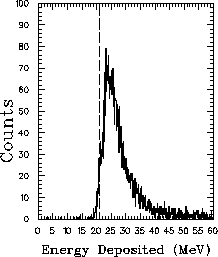There are two different types of relative timing offsets. The first set controls the relative timing between the cells in each of the neutron planes. The other set controls the relative timing between the planes.
The relative timing between the cells in a plane is calibrated by measuring
the time difference between hits in those cells relative to the first cell.
The time of a hit in the first cell (i.e. NA00) is used as a reference and
then, given the calculated path of the cosmic ray, the separation between
the cells, and the assumption that the cosmic ray is travelling at the
speed of light, the time that hits should take place in the other cells is
determined. This calculated relative time difference is then compared to
the actual arrival time of the signals from those cells, and then software
offsets are adjusted to compensate for discrepancies. A sample of the
relative TOF signals from one plane are shown in figure ![]()

Figure: Time difference spectrum between the calculated and actual times
of a COSMIC event in a cell relative to the first cell (i.e. NA00). Note:
The first cell gives a delta function because the estimated time of a
signal is taken with respect to the hit in the first plane. Narrow
distributions around  ns indicate the offsets are set
correctly.
ns indicate the offsets are set
correctly.
The relative timing between the planes is essentially calibrated in the
same manner as between the cells. The difference is that the PP events
(mostly cosmic rays which traverse all six planes) are used. Again the
assumption is made that the cosmic ray is travelling at the speed of
light and,
because the separation between the planes is known, the expected timing
(in this case relative to first plane, NA0) can be compared to the timing
actually observed. Software offset are then adjusted to bring these two
quantities into agreement. Figure ![]() shows the time
difference spectra for a representative run.
shows the time
difference spectra for a representative run.

Figure: Time difference spectrum between the calculated and actual time
for a PP event in the four different neutron planes relative to the first
plane. Note: The first plane gives a delta function because the estimated
time of a signal is taken with respect to the hit in the first plane.
The timing between the planes can also be checked by comparing the gamma
peaks in the time-of-flight spectra of each plane. The gamma peak seen in
the TOF spectrum is the result of detection of gamma rays produced by pion
production and decay in the
target at the same time as the interaction which produces the neutrons.
Since they are produced at the same time there should be a difference in
the total flight time to each plane. This is shown in figure
![]() , and when calibrated the timing differences between planes
agree with the offsets calculated from the PP events.
, and when calibrated the timing differences between planes
agree with the offsets calculated from the PP events.

Figure: Overlay of the time-of-flight spectra of the gamma rays to each
neutron detector plane. TOF determined relative to the corrected RF
signal.